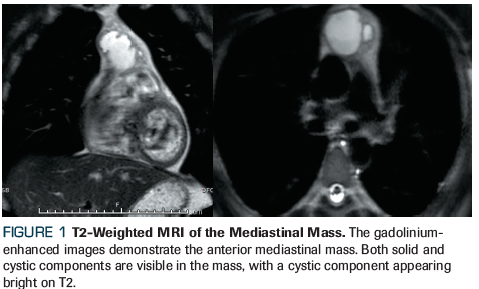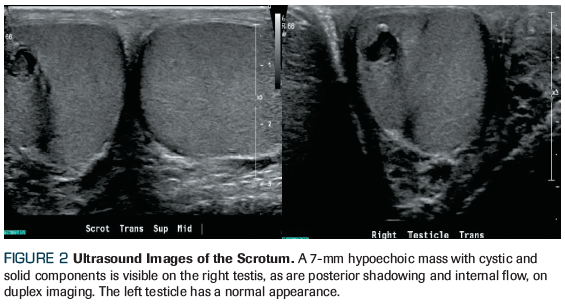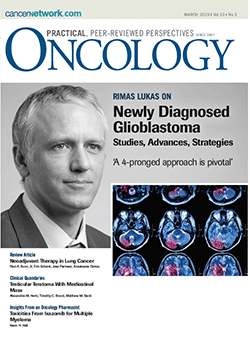A Patient With Pure Teratoma of the Testis Presenting With an Anterior Mediastinal Mass
A 39-year-old man is diagnosed with pure post-pubertal teratoma of the testis. What are the best steps of management?
Oncology (Williston Park). 33(3):107-9.

Alexandria M. Hertz, MD

Timothy C. Brand, MD

Matthew M. Banti, MD

Figure 1. T2-Weighted MRI of the Mediastinal Mass

Figure 2. Ultrasound Images of the Scrotum

Figure 3. H&E and OCT 3/4 Staining of the Tumor

The Case
A 39-year-old man presents with chest pain and shortness of breath. CT scans are ordered, revealing the presence of an anterior mediastinal mass. The patient is sent for a consultation with a cardiothoracic surgeon. Results of cardiovascular, respiratory, and testicular exams completed during this visit are normal. Further evaluation of the mediastinal mass is conducted via MRI (Figure 1), and he is referred to interventional radiology for tissue diagnosis.
Laboratory tests were also performed at this time, which demonstrated the following: beta–human chorionic gonadotropin (beta-HCG), 0.2 mIU/mL (normal, < 5.0 mIU/mL); lactate dehydrogenase (LDH), 226 U/L (normal, 105–333 U/L); and alpha-fetoprotein (AFP), 2.8 ng/mL (normal, < 10.0 ng/mL). Core biopsy of the anterior mediastinal mass demonstrates atypical cells.
A scrotal ultrasound is obtained to assess for a potential germ cell tumor. It reveals a 7-mm mixed cystic and solid hypoechoic mass in the right testicle concerning for a testicular malignancy (Figure 2). PET/CT does not demonstrate lymphadenopathy in the retroperitoneum or elsewhere, or large amounts of increased uptake in the mediastinal mass or testicular lesion. A genital exam by the urologist at that time demonstrates a firm right testicular mass. The patient consents to a right radical inguinal orchiectomy.
Final pathology results reveal pure post-pubertal teratoma of the testis consisting of cysts lined by simple epithelium, as well as ciliated cells surrounded by smooth muscle. Stromal hyalinization and calcification are also present, suggesting the possibility of a burned-out germ cell tumor. The seminiferous tubules show spermatogenesis. Germ cell neoplasia in situ was not identified in the hematoxylin and eosin–stained sections or by immunohistochemistry (placental alkaline phosphatase and octamer transcription factor 3/4) (Figure 3).
Which of the following represents the best next step for management?
A. Obtaining additional tissue from the mediastinal mass (ie, resection)
B. Chemotherapy with bleomycin, etoposide, and cisplatin
C. Radiotherapy
D. Surveillance
E. Retroperitoneal lymph node dissection (RPLND)
CORRECT ANSWER: A. Obtaining additional tissue from the mediastinal mass (ie, resection)
Discussion
The most common underlying causes of an anterior mediastinal mass are thymoma, lymphoma, extragonadal germ cell tumors, and teratoma.[1] Anterior mediastinal masses are rarely symptomatic and are usually discovered incidentally via imaging studies. CT imaging is useful in further characterizing the masses, while MRI helps to differentiate cystic lesions.[2] In general, it is recommended that affected patients undergo a laboratory evaluation to test for levels of beta-HCG, AFP, and LDH, as was performed in this patient.[1]
Approximately 1% to 5% of germ cell tumors manifest in extragonadal locations, with the most common being the mediastinum in adult men.[3] Up to 70% of germ cell tumors in the mediastinum contain teratoma.[4] Synchronous teratoma in the testicle should be considered a secondary primary lesion in the setting of mediastinal teratoma.[5] If a diagnosis of a nonseminomatous germ cell tumor (NSGCT) other than pure teratoma is confirmed, neoadjuvant chemotherapy is generally advocated, followed by surgical resection of the mediastinal mass.[4] In this patient’s case, the recommendation for resection of the mediastinal mass (Answer A) was due to concern for a secondary primary lesion, since an isolated metastasis to the mediastinum without retroperitoneal disease on imaging would have been unlikely.[5] When a different lesion type or multiple primary lesions are suspected, an expert pathologic review is recommended to help guide treatment.
Teratoma is composed of multiple germ cell layers, and is typically defined by the maturation of these elements (mature vs immature).[6] Pure teratoma is relatively uncommon, representing only 2% to 6% of all primary testicular tumors. Thorough pathologic review is necessary to rule out other cell types. The prognosis of pure teratoma is favorable. Previous studies have demonstrated that the relapse rate can be as high as 15% to 30% for clinical stage I disease. Additionally, 30% to 40% of men present with metastatic disease.[7,8] Metastatic pure teratoma of the testis may contain other nonseminomatous components, such as embryonal cells.[7-9]
Treatment of stage I lesions consists of radical orchiectomy. These patients can then either be followed with surveillance, similar to NSGCTs, or offered RPLND to reduce relapse given the risk of occult retroperitoneal metastasis.[7,10,11] Surveillance is favored given the nonaggressive behavior of teratoma.[7,9,11] In the absence of the mediastinal lesion seen in this case, Answers D and E would also be reasonable choices for management of patients with pure teratoma.
Chemotherapy is not effective against teratoma, and continued growth or persistence of the tumor may occur after treatment.[12] For this reason, Answer B is incorrect in the setting of a pure teratoma tumor. Similarly, radiotherapy has been shown to increase the rate of recurrence when given as a solitary therapy for NSGCT.[13] Therefore, Answer C is not a good option for this patient with pure teratoma of the testis. As pure teratoma is relatively uncommon, no specific surveillance protocol is available. General surveillance principles for NSGCT can be used as a surrogate in these patients after shared decision-making with the patient.[10]
Outcome of This Case
This patient had his mediastinal mass resected robotically; it was found to be ectopic pancreatic tissue associated with a thymic cyst. He is currently being monitored on a surveillance regimen for the nonseminomatous germ cell tumor. Several months later, no signs of recurrence have been seen.
Note:The views expressed in this article do not represent those of the Department of Defense or the United States Army.
Financial Disclosure:The authors have no significant financial interest in or other relationship with the manufacturer of any product or provider of any service mentioned in this article.
References:
1. Carter BW, Marom EM, Detterbeck FC. Approaching the patient with an anterior mediastinal mass: a guide for clinicians. J Thorac Oncol. 2014;9:S102-9.
2. Carter BW, Okumura M, Detterbeck FC, Marom EM. Approaching the patient with an anterior mediastinal mass: a guide for radiologists. J Thorac Oncol. 2014;9:S110-8.
3. McKenney JK, Heerema-McKenney A, Rouse RV. Extragonadal germ cell tumors: a review with emphasis on pathologic features, clinical prognostic variables, and differential diagnostic considerations. Adv Anat Pathol. 2007;14:69-92.
4. Shinagare AB, Jagannathan JP, Ramaiya NH, et al. Adult extragonadal germ cell tumors. AJR Am J Roentgenol. 2010;195:W274-80.
5. Luna MA, Valenzuela-Tamariz J. Germ-cell tumors of the mediastinum, postmortem findings. Am J Clin Pathol. 1976;65:450-4.
6. Wein AJ, Kavoussi LR, Campbell MF, et al. Campbell-Walsh urology. 11th ed. Philadelphia: Elsevier Saunders; 2015.
7. Leibovitch I, Foster RS, Ulbright TM, Donohue JP. Adult primary pure teratoma of the testis. The Indiana experience. Cancer. 1995;75:2244-50.
8. Simmonds PD, Lee AH, Theaker JM, et al. Primary pure teratoma of the testis. J Urol. 1996;155:939-42.
9. Porcaro AB, Antoniolli SZ, Martignoni G, et al. Adult primary teratoma of the testis--report on 5 cases in clinical stage I disease. Int Urol Nephrol. 2001;33:657-9.
10. NCCN Clinical Practice Guidelines in Oncology (NCCN Guidelines®). Testicular cancer. https://www.nccn.org/professionals/physician_gls/pdf/testicular.pdf. Accessed February 9, 2019.
11. Rabbani F, Farivar-Mohseni H, Leon A, et al. Clinical outcome after retroperitoneal lymphadenectomy of patients with pure testicular teratoma. Urology. 2003;62:1092-6.
12. Logothetis CJ, Samuels ML, Trindade A, Johnson DE. The growing teratoma syndrome. Cancer. 1982;50:1629-35.
13. Kearsley JH, Tripcony L. Post-orchidectomy radiation therapy alone for patients with early stage non-seminomatous germ cell tumours of the testis. Australas Radiol. 1995;39:47-53.
